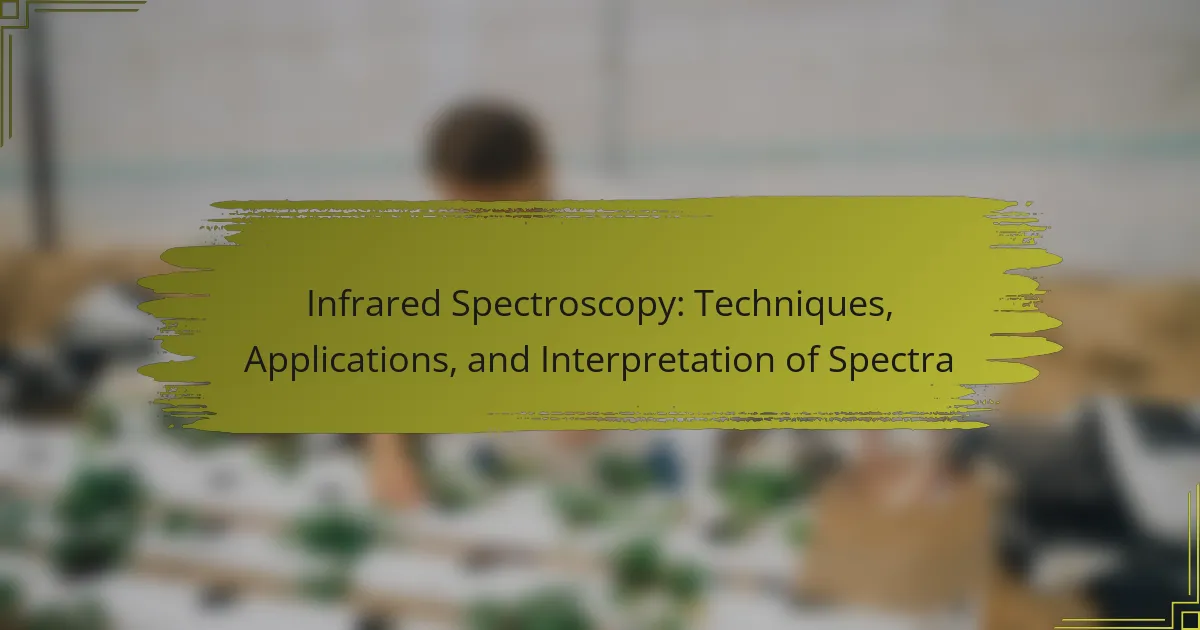
What is Infrared Spectroscopy?
Infrared spectroscopy is an analytical technique used to identify molecular composition. It works by measuring the absorption of infrared light by a sample. Different molecular bonds absorb specific wavelengths of infrared light. This results in a unique spectrum for each substance. The spectrum serves as a molecular fingerprint. Infrared spectroscopy is widely used in chemistry, biology, and materials science. It helps in identifying functional groups and determining molecular structures. The technique is valuable for qualitative and quantitative analysis.
How does Infrared Spectroscopy work?
Infrared spectroscopy works by measuring the absorption of infrared light by a sample. The sample is exposed to infrared radiation, which causes molecular vibrations. Different bonds within the molecules absorb specific frequencies of infrared light. This absorption results in a spectrum that represents the molecular fingerprint of the sample. Each peak in the spectrum corresponds to a specific bond or functional group. The resulting data allows for the identification and analysis of the chemical composition. Infrared spectroscopy is widely used in various fields, including chemistry, biology, and materials science.
What are the key principles behind Infrared Spectroscopy?
Infrared spectroscopy is based on the interaction of infrared radiation with matter. It primarily involves the absorption of specific wavelengths of infrared light by molecular vibrations. These vibrations correspond to the energy levels of molecular bonds. When a molecule absorbs infrared radiation, it transitions to a higher vibrational state. The resulting spectrum provides a unique fingerprint of the molecular structure. This fingerprint can identify functional groups and molecular compositions. The key principles include the selection rules for vibrational transitions and the relationship between molecular structure and absorption frequencies. This technique is widely used in qualitative and quantitative analysis across various fields.
What types of infrared radiation are used in Infrared Spectroscopy?
Infrared spectroscopy utilizes two main types of infrared radiation: near-infrared (NIR) and mid-infrared (MIR). Near-infrared radiation typically ranges from 0.7 to 2.5 micrometers in wavelength. Mid-infrared radiation spans from 2.5 to 25 micrometers. These radiation types correspond to different molecular vibrations and transitions. NIR is often used for analyzing overtone and combination bands. MIR is primarily used for fundamental molecular vibrations. The selection of radiation type influences the sensitivity and specificity of the analysis. These characteristics are essential for applications in chemistry, biology, and materials science.
What are the main techniques used in Infrared Spectroscopy?
The main techniques used in Infrared Spectroscopy include Fourier Transform Infrared Spectroscopy (FTIR), Attenuated Total Reflectance (ATR), and Near-Infrared Spectroscopy (NIR). FTIR is widely used for obtaining infrared spectra of absorption or emission. ATR allows for the analysis of samples without extensive preparation. NIR is effective for analyzing overtone and combination bands. These techniques help in identifying chemical bonds and functional groups in various materials. FTIR is particularly noted for its high sensitivity and speed. ATR is valued for its simplicity and minimal sample requirement. NIR is commonly used in agricultural and pharmaceutical applications.
How does Fourier Transform Infrared (FTIR) Spectroscopy differ from traditional methods?
Fourier Transform Infrared (FTIR) Spectroscopy differs from traditional methods by its ability to capture full spectra simultaneously. Traditional methods, like dispersive infrared spectroscopy, analyze one wavelength at a time, which is time-consuming. FTIR uses an interferometer to collect data in a single measurement. This leads to faster analysis and improved signal-to-noise ratios. FTIR also requires smaller sample sizes compared to traditional methods, enhancing its applicability. Additionally, FTIR can provide better resolution and sensitivity, making it suitable for complex mixtures. These advantages make FTIR a preferred choice in many analytical applications.
What is Attenuated Total Reflectance (ATR) and how is it applied?
Attenuated Total Reflectance (ATR) is a sampling technique used in infrared spectroscopy. ATR allows for the analysis of solid and liquid samples without extensive preparation. The method involves measuring the infrared spectrum of a sample in contact with an internal reflection element. This element typically has a high refractive index, such as diamond or zinc selenide.
When infrared light enters the crystal, it reflects internally and penetrates a short distance into the sample. The evanescent wave generated at the interface interacts with the sample, providing spectral information. ATR is widely applied in various fields, including pharmaceuticals, polymers, and food analysis.
Its advantages include minimal sample preparation, quick analysis times, and the ability to analyze heterogeneous samples. Studies have shown that ATR can effectively identify functional groups and molecular structures in complex mixtures.
What applications does Infrared Spectroscopy have across various fields?
Infrared spectroscopy has diverse applications across multiple fields. In chemistry, it is used for identifying molecular structures and functional groups. In pharmaceuticals, it aids in drug formulation and quality control. In environmental science, it detects pollutants and monitors air quality. In food science, it assesses food composition and quality. In materials science, it characterizes polymers and composites. In forensics, it analyzes substances in crime scene investigations. In agriculture, it evaluates soil and crop health. Each application leverages the ability of infrared spectroscopy to provide detailed molecular information through vibrational transitions.
How is Infrared Spectroscopy utilized in chemical analysis?
Infrared spectroscopy is utilized in chemical analysis to identify molecular structures and functional groups. This technique measures the absorption of infrared light by a sample. Different bonds absorb specific wavelengths, creating a unique spectral fingerprint. Analysts can interpret these spectra to deduce chemical composition. Infrared spectroscopy is commonly used in organic chemistry and materials science. It aids in quality control and material identification. Studies show that infrared spectroscopy can distinguish between similar compounds effectively. This method is rapid and requires minimal sample preparation, enhancing its utility in various applications.
What role does Infrared Spectroscopy play in material science?
Infrared spectroscopy plays a crucial role in material science by providing insights into the molecular composition and structure of materials. It enables the identification of functional groups and chemical bonds within a sample. This technique is widely used for analyzing polymers, metals, and ceramics. Infrared spectroscopy can detect changes in material properties due to environmental factors. It aids in quality control during material production processes. The technique is non-destructive, allowing for the analysis of samples without altering them. Additionally, infrared spectroscopy is instrumental in characterizing nanomaterials and composites. Its ability to provide real-time data enhances research and development in material science.

How do we interpret Infrared Spectra?
Infrared spectra are interpreted by analyzing the absorption peaks corresponding to molecular vibrations. Each peak represents a specific bond or functional group in a molecule. The position of the peaks is measured in wavenumbers, typically expressed in cm^-1. For example, a peak around 1700 cm^-1 often indicates a carbonyl (C=O) group. The intensity of the peaks reflects the concentration of the absorbing species. Additionally, the shape of the peaks can provide insights into molecular interactions. By comparing the obtained spectrum with reference spectra, one can identify unknown compounds. This method is widely used in organic and inorganic chemistry for qualitative analysis.
What are the key features of an Infrared spectrum?
The key features of an infrared spectrum include distinct absorption peaks corresponding to molecular vibrations. These peaks represent specific functional groups within a molecule. The spectrum typically ranges from 4000 to 400 cm^-1. Each peak’s position indicates the type of bond or functional group present. The intensity of the peaks relates to the concentration of the substance. Baseline shifts can occur due to sample preparation or instrument calibration. Additionally, the resolution of the spectrum is influenced by the spectral range and the instrument used. These features allow for the identification and analysis of chemical compounds.
How do absorption peaks indicate specific functional groups?
Absorption peaks in infrared spectroscopy indicate specific functional groups by corresponding to the vibrational frequencies of molecular bonds. Each functional group has a unique set of vibrational modes. These modes absorb infrared radiation at characteristic wavelengths. For example, O-H groups typically absorb around 3200-3600 cm^-1. Similarly, C=O groups show strong absorption near 1700 cm^-1. The position and intensity of these peaks provide information about the presence and concentration of functional groups. This specificity allows chemists to identify compounds based on their spectral fingerprints. Thus, absorption peaks serve as a reliable method for functional group identification in molecular analysis.
What is the significance of wavenumber in spectra interpretation?
Wavenumber is significant in spectra interpretation as it provides a direct measure of energy transitions in molecules. It is defined as the number of waves per unit distance, typically expressed in cm⁻¹. In infrared spectroscopy, wavenumber correlates with the vibrational energy levels of molecular bonds. Each peak in an infrared spectrum corresponds to a specific wavenumber where a molecular vibration occurs. This allows for the identification of functional groups within a compound. The higher the wavenumber, the higher the energy of the vibration. Therefore, wavenumber serves as a crucial reference point for analyzing molecular structures.
What common challenges arise in interpreting Infrared Spectra?
Common challenges in interpreting infrared spectra include overlapping peaks, noise interference, and baseline corrections. Overlapping peaks can complicate the identification of specific functional groups. Noise interference from the instrument or sample can obscure important spectral features. Baseline corrections are often necessary to accurately assess peak intensities. Additionally, sample preparation can introduce variability, affecting reproducibility. Misinterpretation of spectral data may occur due to lack of reference materials or experience. These challenges require careful analysis and expertise to ensure accurate results.
How can overlapping peaks affect analysis accuracy?
Overlapping peaks can significantly reduce analysis accuracy in infrared spectroscopy. When peaks overlap, it becomes challenging to distinguish individual components in a mixture. This can lead to incorrect interpretations of the spectral data. Accurate quantification of substances may be compromised. The presence of overlapping peaks can mask important information about chemical bonds and functional groups. Studies show that even slight overlaps can skew results, affecting both qualitative and quantitative analysis. This is particularly critical in complex samples where precise identification is essential. Therefore, resolving overlapping peaks is crucial for reliable data interpretation in infrared spectroscopy.
What strategies can be employed to resolve spectral ambiguities?
Strategies to resolve spectral ambiguities include the use of advanced spectral deconvolution techniques. These techniques enhance the resolution of overlapping peaks in infrared spectra. Additionally, employing two-dimensional infrared spectroscopy can provide more detailed information about molecular interactions. Utilizing complementary analytical techniques, such as mass spectrometry or nuclear magnetic resonance, can also clarify ambiguous results. Furthermore, enhancing sample purity and concentration can minimize spectral interference. Calibration with known standards improves accuracy in identifying spectral features. Collectively, these strategies enable more precise interpretation of infrared spectra, reducing uncertainties in analysis.

What are best practices for using Infrared Spectroscopy effectively?
Best practices for using Infrared Spectroscopy effectively include proper sample preparation and instrument calibration. Ensuring that samples are clean and appropriately sized enhances data quality. Calibration of the instrument should be performed regularly to maintain accuracy. Utilizing appropriate reference materials can improve spectral analysis. It is also important to select the correct spectral range based on the sample type. Data collection should be done under controlled conditions to minimize interference. Regular maintenance of the spectrometer ensures reliable performance. Following these practices leads to more accurate and reproducible results in infrared spectroscopy.
How can one optimize sample preparation for Infrared Spectroscopy?
To optimize sample preparation for Infrared Spectroscopy, one should ensure the sample is homogeneous and representative. Homogeneity improves the consistency of measurements. Representative samples reflect the actual composition of the larger batch.
Additionally, sample thickness should be controlled to ensure adequate absorbance without saturation. Typically, a thickness of 0.1 to 0.5 mm is ideal for solid samples. For liquids, using a thin film or a suitable cell is recommended.
The use of appropriate solvents can also enhance results. Solvents should not interfere with the infrared spectrum of the sample. It is crucial to select solvents with minimal absorbance in the infrared range.
Furthermore, drying samples completely eliminates moisture interference. Moisture can lead to broadening of peaks and misinterpretation of data.
Finally, using techniques like KBr pellet or nujol mull can aid in the preparation of solid samples. These methods help in achieving a more uniform sample distribution for analysis.
What considerations should be taken into account for solid versus liquid samples?
Solid and liquid samples in infrared spectroscopy require different considerations for accurate analysis. Solid samples may need to be ground into a fine powder to enhance surface area and improve spectral quality. Liquid samples typically require a suitable solvent that does not interfere with the infrared spectrum. The path length for solids is often shorter than for liquids, which can affect absorbance measurements. Sample thickness is crucial; solids may require attenuated total reflectance (ATR) techniques, while liquids can be analyzed in standard cuvettes. Temperature control can also impact the results; solids may be more stable than liquids during analysis. Calibration standards must be appropriate for the sample state to ensure accuracy. These factors collectively influence the reliability of the spectral data obtained.
What troubleshooting tips can enhance Infrared Spectroscopy results?
To enhance Infrared Spectroscopy results, ensure proper instrument calibration. Calibration verifies the accuracy of the spectral data. Regular maintenance of the spectrometer is essential. This includes cleaning the optical components to avoid contamination. Sample preparation should be consistent and appropriate for the analysis. This ensures reproducibility and reliability of results. Use high-quality reference materials for comparison. Reference materials provide a baseline for accurate interpretation. Finally, minimize environmental interferences during measurements. Controlling temperature and humidity can significantly improve data quality.
How can one address issues with baseline noise in spectra?
To address issues with baseline noise in spectra, one can apply baseline correction techniques. These techniques include polynomial fitting, where a polynomial function models the baseline. Another method is the use of rubber band or spline fitting, which adjusts the baseline to follow the spectral data closely. Additionally, smoothing algorithms, such as Savitzky-Golay, can reduce noise while preserving important spectral features. Filtering techniques like Fourier Transform can also help in minimizing noise. Each method aims to enhance the clarity of spectral data for better interpretation. Research has shown that effective baseline correction significantly improves the accuracy of quantitative analysis in infrared spectroscopy.
What steps can be taken to ensure reproducibility in measurements?
To ensure reproducibility in measurements, standardize protocols and conditions. Consistent sample preparation is crucial. Use calibrated instruments for accurate readings. Document all procedures meticulously for reference. Perform multiple trials to confirm results. Implement quality control measures to detect variations. Train personnel uniformly to minimize human error. Validate results with established methods for reliability.
Infrared spectroscopy is an analytical technique used to identify molecular composition through the absorption of infrared light by samples, resulting in unique spectral fingerprints. The article covers the principles of infrared spectroscopy, including its operational mechanisms, types of infrared radiation, and key techniques such as Fourier Transform Infrared Spectroscopy (FTIR) and Attenuated Total Reflectance (ATR). Additionally, it explores the applications of infrared spectroscopy across various fields, including chemistry, pharmaceuticals, and environmental science, while addressing challenges in interpreting spectra and best practices for effective use. The significance of wavenumber, strategies for resolving spectral ambiguities, and troubleshooting tips for enhancing measurement reproducibility are also discussed.
